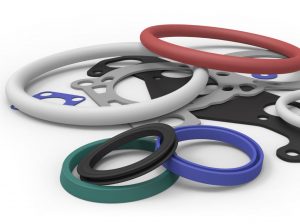When it is time to replace a seal, knowing the differences between a gasket vs. o-ring is essential for the application to function as designed. Each type of mechanical seal is used in numerous applications ranging from engines, motors, machines, and pumps to cylinders, piping, valves, tools, equipment, and so on. Both gaskets and o-rings serve similar purposes—to effectively join and seal mated surfaces between parts to reduce friction, resist pressure, and prevent gasses, fluids or lubricants from exiting and entering between mated surfaces.
 Despite these similarities, there are fundamental differences between the two. Most obviously, the two sealing devices vary significantly in appearance. The size and shape of each are vastly different. One look will tell you that they are not interchangeable parts. The various functions a particular seal must accomplish are determined during an application’s design phase. In other words, each seal, whether gasket or o-ring, is designed for a specific application to function in a particular environment. In addition to design considerations, the seal must be made of certain materials that hold the necessary properties for the seal to perform as designed. Design and function will largely determine whether a gasket or o-ring is right for you.
Despite these similarities, there are fundamental differences between the two. Most obviously, the two sealing devices vary significantly in appearance. The size and shape of each are vastly different. One look will tell you that they are not interchangeable parts. The various functions a particular seal must accomplish are determined during an application’s design phase. In other words, each seal, whether gasket or o-ring, is designed for a specific application to function in a particular environment. In addition to design considerations, the seal must be made of certain materials that hold the necessary properties for the seal to perform as designed. Design and function will largely determine whether a gasket or o-ring is right for you.
Should I Use a Gasket or an O-Ring
Selecting a Gasket
Gaskets are designed to insert between two surfaces and mate them together to form an airtight seam between one or more stationary component parts. Thus, gaskets are flat and must consist of malleable material—the functionality of gaskets relies on the required compressive force to prevent the emission or absorption of unwanted fluids, liquids, or gasses that could result in part failure. Though flat, gasket shapes, sizes, and dimensions vary considerably to adhere to the design of the mated parts or joints.
While some gaskets are rounded and circular, others are oblong, square, rectangular, triangular, grooved or Kammprofile, spiral wound, crescent-shaped, and even jacketed—whatever shape is needed to meet the design requirements.
Though materials for gaskets are as varied as their design considerations, the material must be pliable to conform to the mated surfaces and hold the mechanical properties to meet the application requirements. Elastomeric polymer materials like nitrile, Viton, neoprene, and silicone are ideal for either high pressure or, in the case of the latter, extreme temperature applications. However, many gasket applications call for foams, corks, composites, and metals, depending on the mechanical properties required for the application.
Selecting an O-Ring
As o-rings are a type of seal, they are, by definition, a variety of gasket that serves similar functions as other gaskets. Nonetheless, the key characteristic of an o-ring, as the name implies, is its toric, doughnut-like shape. Sometimes referred to as a packing joint or toric joint, the only design distinctions for these circular, hollow-centered, mechanical seals are size, thickness, and dimension. O-rings typically fit into a groove at the interface where two rounded surfaces are joined together. The seals can also be used in static or dynamic applications, such as jet engines and automobile engines. Their torus shape allows for easy installation over or between such cylindrical-shaped components as pipes, faucets, and hoses.
As with gaskets, o-rings are made of elastomeric polymers like nitrile rubber, silicone rubber, and fluoropolymers. When selecting an o-ring for an application, it’s essential to factor in not only its operating conditions and the type of environment it will function in but what kind of oils, solvents, and gasses the material is compatible with. Knowing how the material will hold up in certain temperatures or under severe pressure is vital to prevent product failure.
In fact, regarding the latter, pressure and temperature considerations concerning design features will influence which type of seal, gasket or o-ring, is better suited for an application. O-rings can maintain their integrity under high pressure, some exceeding 5000 PSI (pounds per square inch). Usually in servicing engines, pipes, pumps, valves, shafts, and couplings to secure oils and fuels, refrigerants and fluids, or gasses, vapors, and water. As for gaskets, due to their flat surfaces, they are commonly used in extreme temperature applications. Think engine seals for cars, trucks, tractors, jets, outboard motors, etc. Gaskets are also used in such applications as electronics, electrical motors, generators, and electronic and telecommunication devices.
When considering a gasket vs. o-ring, design, and function will determine which seal is better suited for an application. To further assist you in selecting the right seal for your application, contact one of the professionals at Manufacturer’s Rubber and Supply.


